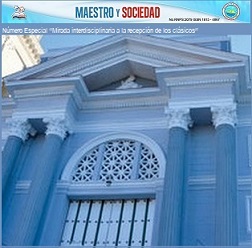Ancient stories in modern songs: approach to a didactic strategy
Keywords:
music, learning, history, classical cultureAbstract
The work of the professor is in the search of means and resources that allow the study and the optimal learning in any part of the branches to study. In this sense, it has been shown that music in the educational stage favors the attention and memorization of data, in which it intervenes favorably in all the areas in which students can face. The use of music in the class of classical cultures, in the most specific way, the improvement of creativity, the knowledge of history, the realities of myth. It becomes an attractive and sensitizing means with previous cultures and directly influences their daily history. For what "Ancient stories in modern songs". Approach to a didactic strategy "shows the innumerable advantages of the use of songs in the educational process.
References
2. Griffee, D. T. (1992). Songs in Action. London: Prentice Hall.
3. Ken, J (2001). Power metal épico. Recuperado de https://keny20101.wordpress.com/power-metal/power-metal-epico/
4. Kramsch, C. (2000). Language and Culture. Shanghai: Shanghais FL Education Press.
5. Larsen-Freeman, D. & Long, M. H. (2000). An Introduction to SLA Research. Shanghai: Shanghais FL Education Press.
6. Levitin, D. J. (2006). Tu cerebro y la música. El Estudio Científico de una Obsesión Humana. Barcelona: RBA
7. Nenuhin, Y. (1997). La música y el proceso creativo humano. Salamanca: Música, Arte y Proceso.
8. Obiols, N. (1998). Cómo desarrollar los valores a partir de la Literatura. Barcelona: Ceac.
9. Pérez A., S. (2008). El Ritmo: Una Herramienta Para la Integración Social. Ensayos, Revista de la Facultad de Educación de Albacete, 23, 189-196.
10. Pérez A., S. (2009). Construcción de la identidad europea en el aula a través del ritmo. [Cd-Room]. INECE’09-III Jornadas Internacionales UPM sobre Innovación Educativa y Convergencia.
11. Pérez A., S., & Leganés L., E. N. (2012). La Música como herramienta interdisciplinar: un análisis cuantitativo en el aula de Lengua Extranjera de Primaria. Revista de Investigación en Educación, 10(1), 127-143.
12. Quintana, J. M. (1998). Pedagogía axiológica. La Educación ante los valores. Madrid: Dykinson.
13. Rivers, W. M. (1997). Interactive Language Teaching. Cambridge: Cambridge University Press.
14. Santos A., J. (1997). Música maestro. Trabajando con música y canciones en el aula. Carabela, 41, 129-151.
15. Salcedo M., B (2007). Importancia de la música como recurso en el aprendizaje escolar. Revista Recuperada de www.pag.org.mx › index.php › PAG › article › download
Downloads
Published
How to Cite
Issue
Section
License
This journal provides immediate open access to its content, based on the principle that offering the public free access to research helps a greater global exchange of knowledge. Each author is responsible for the content of each of their articles.



























 Universidad de Oriente
Universidad de Oriente 